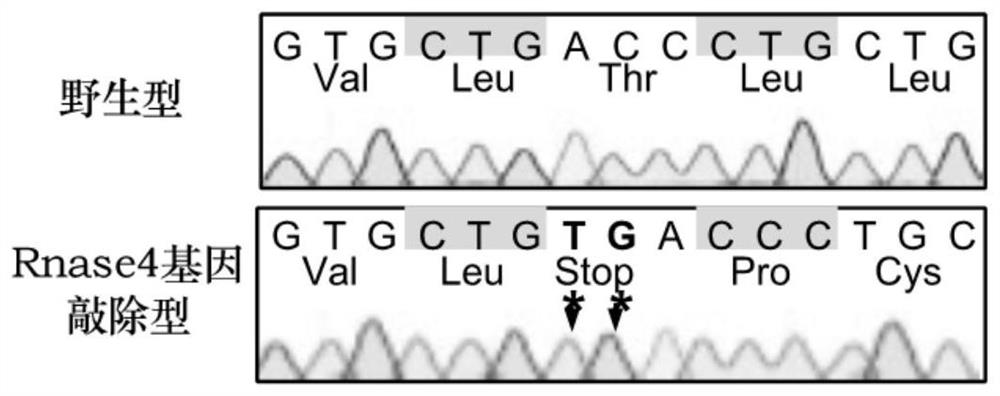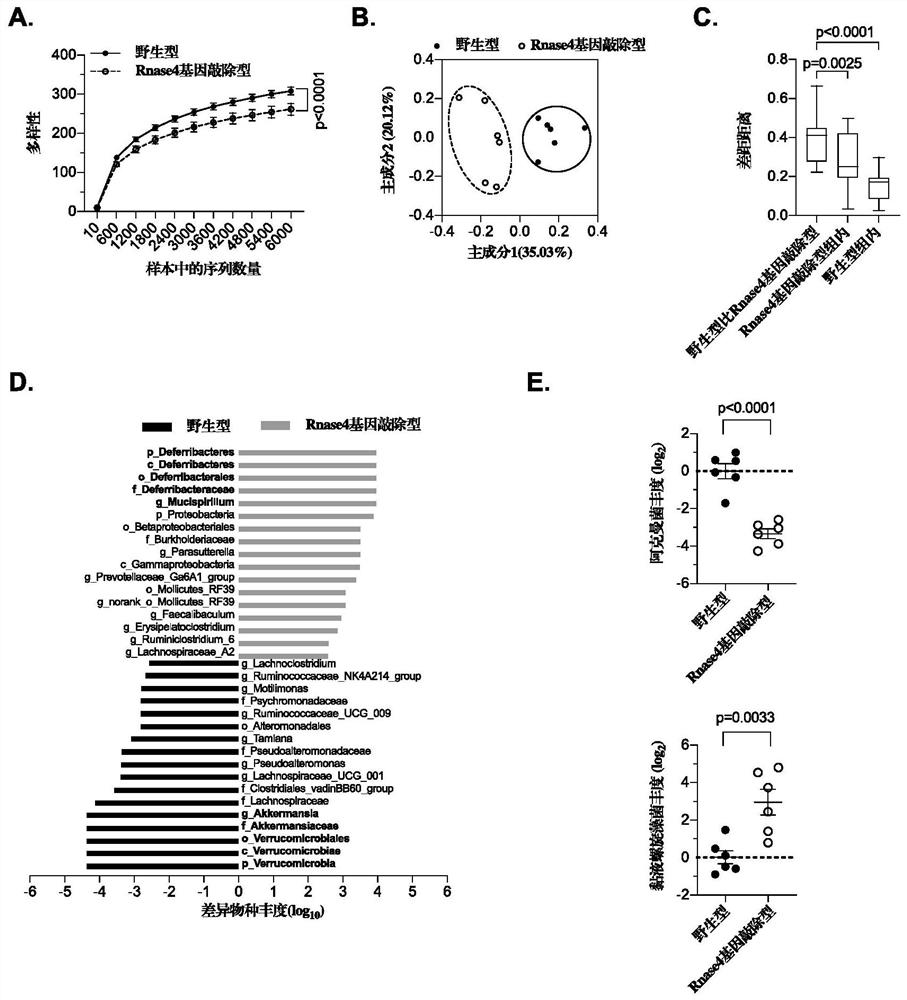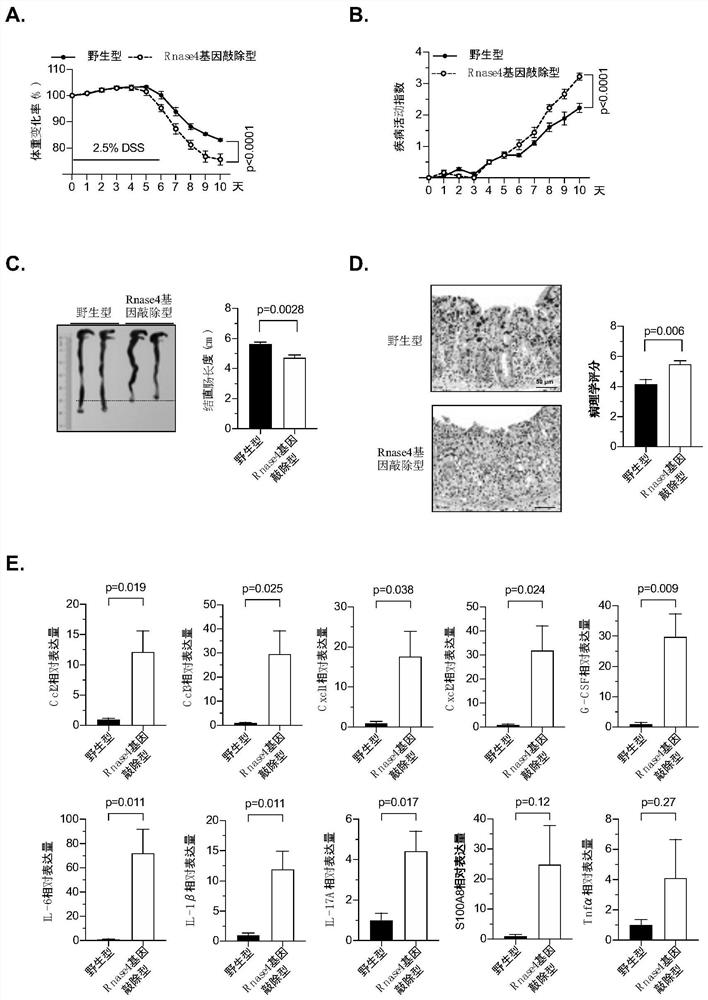Use of antimicrobial peptides for maintaining abundance of intestinal Akkermansia bacteria
A technology of antimicrobial peptides and intestinal flora, applied in the field of antimicrobial peptides, to slow down the progress, inhibit the growth of Spirulina mucus, and promote the growth of Akkermansia
- Summary
- Abstract
- Description
- Claims
- Application Information
AI Technical Summary
Problems solved by technology
Method used
Image
Examples
Embodiment 1
[0044] Example 1. RNASE4 can change the composition of intestinal flora
[0045] 1.1 Experimental method
[0046] In this example, 16S rDNA amplicon high-throughput sequencing was used to compare the differences in bacterial composition in the fecal DNA samples of 6 wild-type mice and 6 Rnase4 knockout mice matched in gender, age, and body weight. .
[0047] Among them, the Rnase4 knockout mouse was constructed by TALEN technology. The specific construction process is as follows: The artificially modified FokI is used to form a dimer, and under the guidance of the TALEN arm with a DNA recognition domain, the activity of endonuclease is exerted. , specifically cut off the target gene DNA, use TALEN technology to insert the "TG" base in the Rnase4 gene on chromosome 14 of the mouse genome, introduce point mutations to cause frameshift, construct the Rnase4 gene knockout mouse, after sequencing, the Rnase4 gene The genome of knockout mice successfully inserted "TG" bases, causi...
Embodiment 2
[0054] Example 2. RNASE4 has a protective effect during the occurrence of enteritis
[0055] 1.1 Experimental method
[0056] Enteritis model was induced by dextran sulfate sodium (DSS). First, the DSS drug powder was weighed and dissolved in sterilized water to a final concentration of 2.5% (ie, 2.5 g / 100 ml). Then, 8-week-old wild-type and Rnase4 knockout mice were taken, and during the modeling process, the drinking water was changed to 2.5% DSS solution. Changes in body weight, fecal dryness, and blood in the stool were recorded on the 1st to 10th day of induction of enteritis.
[0057] Weight Score: 0, no weight loss; 1, 1-5% decrease; 2, 6-10% decrease; 3, 11-20% decrease; 4, more than 20% decrease; stool score: 0, solid stool; 1, Solid stool, easily deformed; 2, unformed stool; 3, liquid stool; blood in stool score: 0, negative for occult blood test; 1, positive for occult blood test; 2, visible blood in stool; 3, severe blood in stool.
[0058] The disease activity...
Embodiment 3
[0061] Example 3. Intestinal flora plays a role in RNASE4-related enteritis
[0062] 1.1 Experimental method
[0063] In this example, the intestinal flora of Rnase4 knockout mice was transplanted into mice treated with mixed antibiotics by fecal bacteria transplantation. On this basis, the DSS-induced enteritis model was used to analyze the intestinal flora Role in RNASE4-associated enteritis.
[0064] The specific process is as follows: firstly prepare a mixed antibiotic solution (containing 1g / L ampicillin, 1g / L neomycin, 1g / L metronidazole, 0.5g / L vancomycin), and then drink the drinking water of 12 wild-type mice. The water was replaced with the above mixed antibiotic solution for a total of 4 weeks. After 4 weeks of treatment, the feces of each mouse were collected and dissolved in sterile PBS (the dissolving ratio was 100 mg feces / 1 mL PBS), followed by 4 serial serial dilutions at a ratio of 1:10, and each 50 μL was applied to LB plates , perform anaerobic and aerob...
PUM
| Property | Measurement | Unit |
|---|---|---|
| molecular weight | aaaaa | aaaaa |
Abstract
Description
Claims
Application Information
 Login to View More
Login to View More - R&D
- Intellectual Property
- Life Sciences
- Materials
- Tech Scout
- Unparalleled Data Quality
- Higher Quality Content
- 60% Fewer Hallucinations
Browse by: Latest US Patents, China's latest patents, Technical Efficacy Thesaurus, Application Domain, Technology Topic, Popular Technical Reports.
© 2025 PatSnap. All rights reserved.Legal|Privacy policy|Modern Slavery Act Transparency Statement|Sitemap|About US| Contact US: help@patsnap.com



